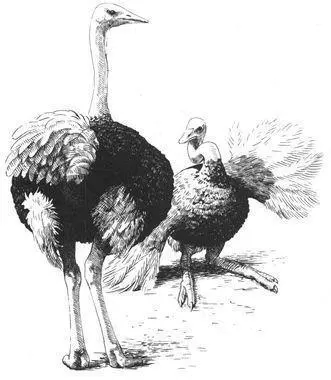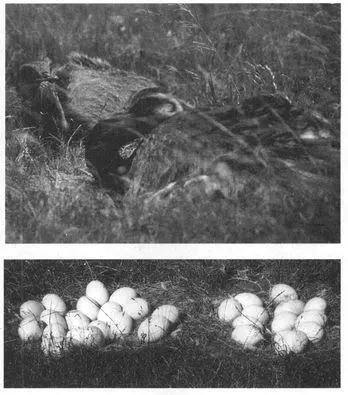EMU
IDENTIFICATION: The second-largest living bird (5–6 feet tall), with shaggy, brown plumage and bare patches of blue skin on the face and neck. DISTRIBUTION: Australia. HABITAT: Arid plains, semidesert, scrub, open woodland. STUDY AREAS: Barcoo River and Alice Downs areas, Central Queensland, Australia; Division of Wildlife Research, Helena Valley, Western Australia; Berlin Zoo and Melbourne Zoological Gardens.
GREATER RHEA
IDENTIFICATION: Similar to Ostrich but smaller (up to 4½ feet tall) and with overall grayish brown plumage in both sexes. DISTRIBUTION: Southeastern South America. HABITAT: Open brush, grassland, plains. STUDY AREA: Near General Lavalle, Buenos Aires Province, Argentina; subspecies R.a. albescens.
Social Organization
Ostriches associate in flocks and frequently form sex-segregated groups. All-male flocks may contain up to 40 individuals, many of them juveniles, who travel with each other for long periods. Emus generally associate in pairs or groups of 3–10 birds, while Greater Rheas gather in flocks of 15–40 birds outside of the mating season. All three species have a wide variety of mating systems (discussed below). These are notable for their various forms of POLYANDRY (females mating with several males) and the fact that—in Emus and Greater Rheas—all incubation and chick-rearing is performed by males without any help from females.
Description
Behavioral Expression: Male Ostriches perform a homosexual courtship dance to each other that is distinct from heterosexual interactions. Same-sex courtships consist of a sequence of three activities, performed by sexually mature adult males in full nuptial plumage (black-and-white feathers, with a red flush on the face and legs). First, there is a dramatic APPROACH in which one male runs rapidly toward his chosen partner—often achieving speeds of 25–30 mph—and stops abruptly just short of the other male. Then he launches into frenzied PIROUETTE DANCING, a high-speed, energetic circling in place beside his partner. This whirling may occur in a series of bursts, each lasting for several minutes. Finally, in KANTLING, the male drops to the ground next to his partner and rocks steadily from side to side, fluffing out his tail and sweeping the ground with his wings in an exaggerated fashion. All the while, he twists his head and neck in a continuous corkscrew action and repeatedly inflates and deflates his throat. The male being displayed to may acknowledge the dance with his posture, or he may simply maintain a calm stance devoid of alarm or aggression. Homosexual courtships are distinct from heterosexual ones in a number of respects: neither the running approach nor pirouette dancing occur in male-female interactions. Kantling is performed in heterosexual contexts but differs because it is usually accompanied by singing (when males display to females, they frequently produce a booming call), and it is significantly shorter. Same-sex displays last for 10—20 minutes, while opposite-sex ones rarely exceed three minutes. Also, symbolic feeding and nest-site displays are components of heterosexual but not homosexual courtships.
A male Ostrich ( right, on the ground ) courting another male with the “kantling” display

Although no copulation takes place between courting male Ostriches, homosexual mating has been observed in pairs of male Emus. A sexual interaction begins with one male approaching the other, stretching his neck upward and erecting his neck feathers so that they stand out horizontally, while grunting deeply. The two birds begin following and chasing each other; if the male who initiated the activity is behind the other, he may make treading movements with his feet, indicating his intention to mount the other. Often, however, it is the initiating male who lies flat on the ground as an invitation for the other male to mount. The males may also take turns mounting each other. The mounting male lies down behind his partner, resting his breast on the other’s rump, and uses his heels to slide forward until he covers most of the other male. While copulation is taking place, the mountee makes soft grunting noises (not usually heard during heterosexual matings), and the mounter gently toys with the feathers on his partner’s upper back. After mating, his erect penis is often visible: the male Emu, along with other ratites, is one of the few birds in the world that has a penis (most male birds simply have a cloacal, or genital, opening).
Joint parenting in male Greater Rheas: two males in Argentina (
above ) sitting on their double nest, which contains two sets of eggs (
below ) that are frequently rolled between the coparents

Male Emus also sometimes coparent with each other: two (and occasionally three) males may attend one nest at the same time, incubating all the eggs together. Such nests often contain SUPERNORMAL CLUTCHES of 14–16, and sometimes more than 20, eggs. This is over twice the number found in nests attended by single males, probably because more than one female has laid in them. Unlike single fathers, male coparents are able to take a break from incubating while their partner sits on the nest; they also sometimes roll the eggs between them while on the nest together. Although they are probably not sexually involved with one another, the two fathers cooperate in raising their chicks together, calling to them with “purr-growls” and jointly defending them from predators. A similar phenomenon is found in Greater Rheas: pairs of males occasionally sit on “double nests” that are close to or touching one another; they incubate the eggs together and jointly parent the chicks when they hatch. Most such nests begin as standard nests with only one male incubating, after which another male joins him and begins transferring eggs to his half of the nest; later, eggs may be transferred back and forth between the twin nests. Unlike Emu nests belonging to male coparents, Rhea double nests usually have a combined number of eggs that is the same as for single nests. Male coparents are different from male nest helpers, which are also found in Rheas. About a quarter of breeding males are assisted by an adolescent male, who incubates and raises (on his own) a clutch of eggs fathered by the adult while the latter goes off to start a new family. This differs from male coparenting in that the two nests are widely separated from one another, each contains the full clutch size of a single nest, the two males never share parenting duties, and the helper is always an adolescent male.
Female Ostriches are occasionally transvestite, having full black-and-white male plumage (along with underdeveloped ovaries).
Frequency: Homosexual courtship in Ostriches is quite common in some populations, occurring two to four times a day (usually in the morning). Sexual behavior between male Emus has so far only been observed in captivity, but it does occur repeatedly between partners. Among Greater Rheas, joint parenting between males occurs in about 3 percent of all nests; Emu coparenting probably occurs at a similar rate.
Orientation: In Ostriches, 1–2 percent of all adult males engage in homosexual courtship in some populations. Male Ostriches who court other males typically ignore any females that may be present; they are probably solitary birds that participate in little, if any, heterosexual interactions. Most Emus and Rheas that participate in male coparenting have probably mated and/or paired with females earlier in the season prior to parenting with another male. Male Emus may also have a latent capacity for bisexuality, as evidenced by the occurrence of sexual behavior between captive males (at least one of whom had previously mated heterosexually). However, individual life histories and the full patterns of sexual orientation have not yet been systematically studied in this species.
Читать дальше














